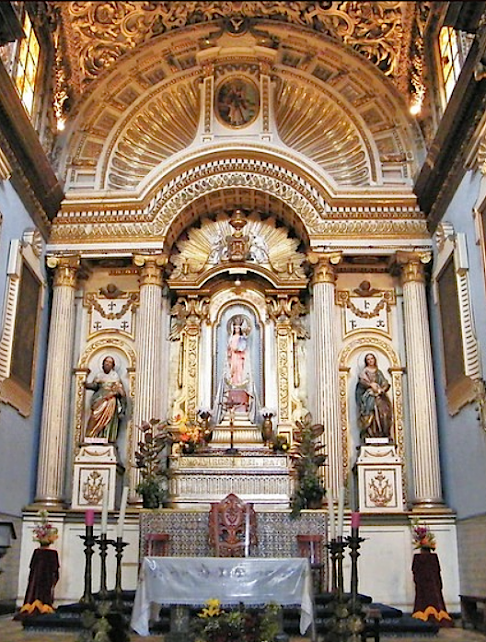The interior of this temple preserves its rich stucco ornament, being among the first in the City of Puebla to use this material. The vaults above the nave are alive with intertwined plant and anthropomorphic motifs.
The octagonal dome above the crossing is also a masterpiece of polychromed stucco. In the center the Immaculate Conception is surrounded by musical angels and eight figures of the holy virgins and other martyrs.
These include Santa Catalina de Alejandría, accompanied by a toothed wheel, Santa Bárbara, who carries a tower, Santa Úrsula who carries in her hands a banner with the Marian monogram and the palm of martyrdom, and Santa Lucía, holding a tray with eyes.In the vault of the decorative under choir is the relief image of John Duns Scotus, a Franciscan who notably defended the dogma of the Immaculate Conception, flanked by Hapsburg double-headed eagles
The main altar preserves a neoclassical altarpiece in which showcases the venerated image of the Virgen del Rayo.
The main altar preserves a neoclassical altarpiece in which showcases the venerated image of the Virgen del Rayo.
But the principal interest of the church is its collection of fine sculptures attributed to the workshop of the noted Cora family of colonial sculptors of Puebla, whose activity spans the entire 18th century, from baroque to neoclassical in style. The most prominent members were José Villegas Cora († 1786), called the “great master”, who according to tradition started the workshop, his nephews the prolific Zacarías (1752(?)-1819), José, and Antonio Villegas Cora, brother of the “great master” and master of polychromy.
The statues of San Joaquín and Santa Ana in the main altarpiece, San Francisco and San José in the transept, as well as the monumental sculpture of San Cristóbal in the choir loft? are all from the Cora workshop. They preserve their original estofado finish, achieved here by means of a layer of colored varnish on silver foil, tooled to imitate precious stones or rich fabrics.
The image of San Joaquín is among the few examples of signed colonial sculptures, its base reading “YEAR OF 1785 CORA fecit”.
The most striking piece in this group is Saint Christopher, the “Bearer of Christ” and patron of the hospital, reputedly the work of Zacarías Cora.
text © 2022 Richard D. Perry
images courtesy of N Brooker and ELTB







No comments:
Post a Comment